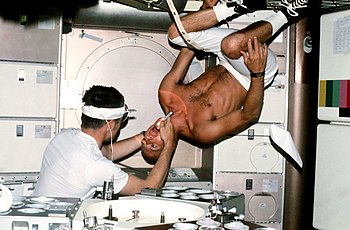Aerospace medicine
Aerospace medicine, also called flight medicine, is preventive or occupational medicine in which patients are pilots, air crews, or astronauts. specialty strives to treat or prevent conditions to which aircrews are particularly susceptible, applying medical knowledge to human factors in aviation, and is therefore a critical component of aviation safety.
A military physician in aviation medicine may be called a flight surgeon and a civilian physician is an aviation medical examiner. One of the biggest differences between military and civilian flight medics is the requirement for the military flight surgeon to log flight hours.
Overview
Broadly speaking, this subdiscipline strives to discover and prevent various adverse physiological responses to hostile biological and physical stresses encountered in the aerospace environment. Issues range from life support measures for astronauts to recognizing a blocked ear in a baby traveling in an airplane at high cabin pressure altitude. The aeromedical certification of pilots, crew members and patients is also part of Aeronautical Medicine. A final subdivision is the AeroMedical Transport Specialty. These military and civilian specialists are concerned with protecting aircrews and patients being transported by AirEvac aircraft (helicopters or fixed-wing aircraft).
Atmospheric physics potentially affects all air travelers regardless of aircraft. As humans ascend through the first 9,100-12,300 m (30,000-40,000 ft), the temperature decreases linearly at an average rate of 2 °C (3.6 °F) per 305 m (1,000 ft). If the temperature at sea level is 16°C (60°F), the outdoor air temperature is approximately -57°C (-70°F) at 10,700m (35,000ft). Pressure and humidity also drop, and the crew is exposed to radiation, vibration, and acceleration forces (the latter are also known as g-forces). Aircraft life support systems such as oxygen, heat, and pressurization are the first line of defense against the most hostile aerospace environment. Higher performance aircraft provide more sophisticated life support equipment such as "G suits" to help the body resist the adverse effects of acceleration, in conjunction with pressurized breathing apparatus, ejection seats, or other escape equipment.
Every factor that contributes to safe flight has a failure rate. The crew of an airplane is no different. Aviation medicine aims to keep this rate in the humans involved at or below a specified risk level. This risk standard also applies to airframe, avionics, and systems associated with flights.
AeroMedical exams are aimed at detecting an increased risk of sudden disability, such as a tendency to myocardial infarction (heart attacks), epilepsy, or the presence of metabolic conditions, diabetes, etc., which can lead to a dangerous condition at altitude. The objective of the aviation medical examination is to protect the life and health of pilots and passengers by offering reasonable medical guarantees that a person is fit to fly. Other protected conditions, such as color blindness, may prevent a person from flying due to the inability to perform a necessary function. In this case, to differentiate green from red. These specialized medical exams consist of physical examinations performed by an Aviation Medical Examiner or Military Flight Surgeon, physicians trained to evaluate potential aircrew for identifiable medical conditions that could cause problems while performing duties in the air. Furthermore, this unique population of crews is a high-risk group for various diseases and harmful conditions due to irregular work shifts with irregular sleep and irregular meals (usually carbonated drinks and high-energy snacks) and work-related stress.
Clinical picture
Some of the most common disturbances and effects of flight are:
- Hipoxia
- Barotrauma
- Black Vision
- Red Vision
- Fear of flying
- Cinetosis
- Space adaptation syndrome
- Syndrome of the tourist class
- Jet lag
- Aerospace Medicine Instruction Center
Contenido relacionado
Gaspar Llamazares
Category:Medical journals
Blastocoel
